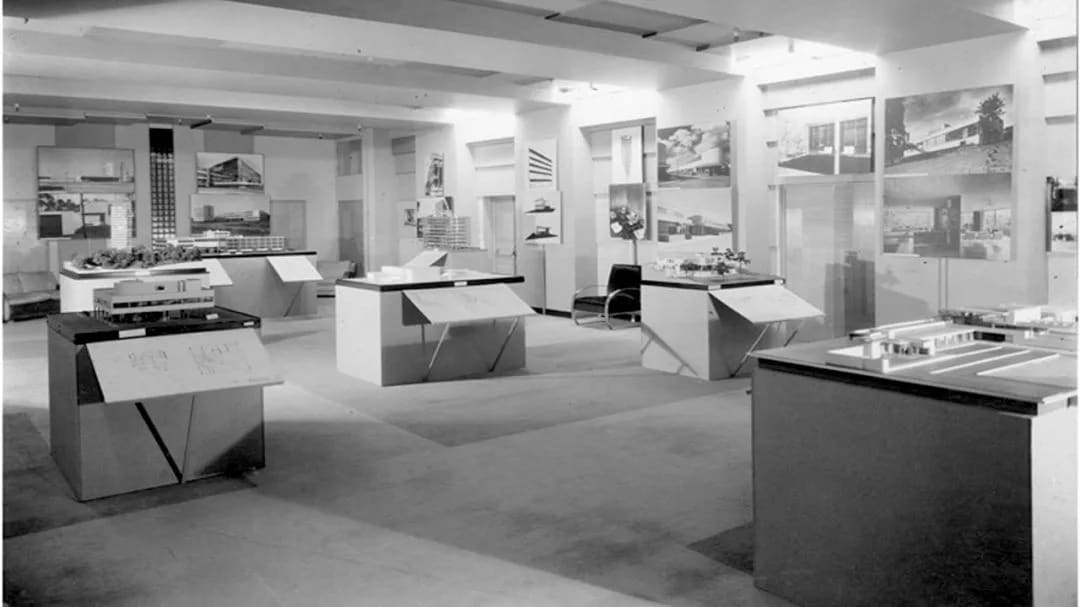Neither department stores as venues, nor full scale display houses–such as the Aluminaire House which premiered in the galleries of the Grand Central Palace in New York in 1931 and now finally at home in Palm Springs–were new in the 1930s. Since the mid 19th century demonstration houses had converted exhibitions from retrospective gatherings of the best of recent vintage into a projection of possible futures.
Prince Albert commissioned the Model Houses, built outside the great Crystal Palace, for the Great Exhibition of 1851. The renowned 1914 Futurist Exhibition in Milan not only defined a movement, but it also conjured a non-existing architecture to convey a sense of epochal change. Throughout the 1920s and 1930s public displays of architecture were the catalytic converters of the Modern Movement.
When the Museum of Modern Art’s inaugural architecture exhibition of “International Style” buildings continued its nationwide tour in summer 1932 at Bullocks Wilshire department store in Los Angeles, it might be said to have brought the exploding culture of exhibitions of modernist architectural designs to a crescendo, even as the forces of the worldwide economic depression spelled a downturn in construction. Later was Durell Stone’s 1940 ‘Cabin in the Sky’ on a Rockefeller Center rooftop. Marcel Breuer’s 1948-1948 ‘House in a Garden’ on the grounds of the Museum of Modern Art. If Modernism never gained the upper hand in the building industry, it gained a huge foothold in the public imagination through a burgeoning nexus of exhibitions.
Of course, architecture once built is, in a sense, always on view. But it was exhibitions, especially of full-scale demonstration houses, that allowed the public to experience spaces of a sort that scarcely existed and which they might otherwise never be able to tour.
Barry Bergdoll is the Meyer Schapiro Professor of art history in the Department of Art History and Archaeology at Columbia University and former curator in the Department of Architecture and Design at the Museum of Modern Art, New York, where from 2007 to 2013 he served as Philip Johnson Chief Curator of Architecture and Design, and a member of the Pritzker Prize Jury. Holding a B.A. from Columbia, an M.A. from King’s College, Cambridge, and a Ph.D. from Columbia, his broad interests center on modern architectural history and the intersections of architecture and new technologies in the modern period, especially photography and film.
Bergdoll has organized, curated, and consulted on many landmark exhibitions of 19th and 20th-century architecture including “Building Collections: Recent Acquisitions of Architecture” opening at MoMA in November 2010; “Rising Currents: Projects for New York’s Waterfront” at MoMA (through October 11, 2010); “Bauhaus 1919-1933: Workshops for Modernity” at MoMA (2009-10); “Home Delivery: Fabricating the Modern Dwelling” at MoMA (2008); “Lost Vanguard: Soviet Modernist Architecture, 1922-32” at MoMA (2007); “Mies in Berlin” at MoMA (2001), with Terence Riley; “Breuer in Minnesota” at the Minneapolis Institute of Arts (2002); “Les Vaudoyer: Une Dynastie d’Architectes at the Musée D’Orsay, Paris (1991); and “Ste. Geneviève/Pantheon; Symbol of Revolutions,” in Paris and at the Canadian Centre for Architecture, Montreal (1989).
He is author or editor of numerous publications including, Bauhaus 1919-1933: Workshops for Modernity (winner of the 2010 Award for Outstanding Exhibition Catalogue, Association of Art Museum Curators); Home Delivery: Fabricating the Modern Dwelling (winner of the 2010 Philip Johnson Book Award, Society of Architectural Historians); Mies in Berlin (winner of the 2002 Philip Johnson Book Award, Society of Architectural Historians and AICA Best Exhibition Award, 2002); Karl Friedrich Schinkel: An Architecture for Prussia (winner of the 1995 AIA Book Award); and Lẻon Vaudoyer: Historicism in the Age of Industry; and European Architecture 1750-1890, in the Oxford History of Art series.
$35 VIP Front Orchestra Reserved Seating
$20 General Admission
Things to Know
This event is for 12 and older.
The entrance to the Annenberg Theater is located behind the Annenberg Theater Box Office, adjacent to the Palm Springs Art Museum's North Parking Lot.
Ample free public parking is available in the multi-level public garage across from the Palm Springs Art Museum.
Handicap parking is available.
This event is wheelchair accessible.
The organizer of this event is Modernism Week.
Event Check-in Location
Annenberg Theater
Palm Springs Art Museum
101 N Museum Dr
Palm Springs, CA 92262
View Map
Photo Credits: Columbia University – Claude-Marie Ferrier – Museum of Modern Art – Gottscho-Schleisner







